
Hi Archinect!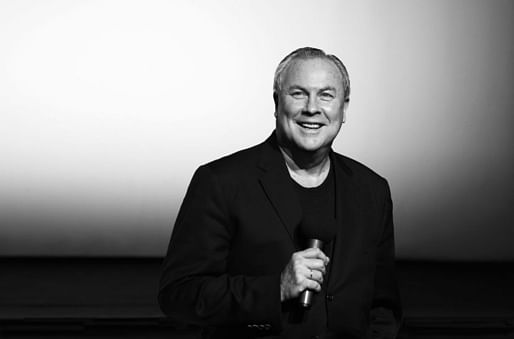
Full-ish house in Piper tonight. From the GSD's website:
Robert Wilson is among the world's foremost theater and visual artists, acclaimed for stage works that integrate dance, movement, lighting, sculpture, music, and text in striking, emotionally charged images. His productions include Einstein on the Beach (1976), co-written with Philip Glass, Beckett's Krapp's Last Tape, Puccini's Madama Butterfly, Debussy's Pelléas et Melisande, Brecht/Weill's Threepenny Opera, Fontaine's Fables, Homer's Odyssey, and many others. His collaborators have included Tom Waits, Susan Sontag, Laurie Anderson, William Burroughs, and Jessye Norman. A member of the American Academy of Arts and Letters, and a Commandeur des Arts et des Lettres, he has received numerous awards, including the Golden Lion of the Venice Biennale. Wilson is the founder of The Watermill Center, a laboratory for performing arts in Watermill, New York. Supported by by the Rouse Visiting Artist in Residence Fund.

5:45 pm: Sílvia Benedito makes introductions. Robert Wilson's talk is part of an initiative on the body. SB quotes Wilson:
"I'm not afraid to repeat things over, and over, and over. I think the more mechanical we are, the more we do it, the more we understand about it. Many people think it loses life, but I don't think so--we become freer...one becomes free to think about other things."
SB: His images are aesthetically striking and emotionally charged...and have earned a...[worldwide following]. ...Wilson has been honored with the Pulitzer Prize and numerous other awards.
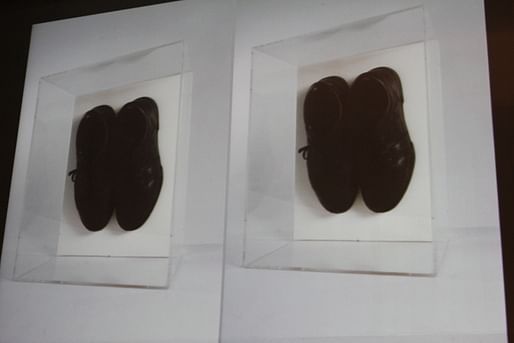
5:49 pm: RW takes the podium. He stands silent, looking down, for about a minute. He slowly looks up, then down again. This image of shoes is projected at the front of the room.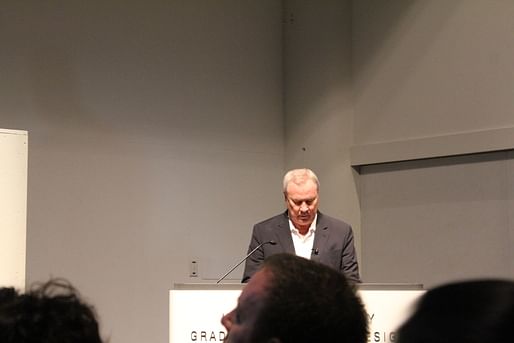
5:51 pm: silence. RW looks up again, and looks around the room. The interpreter (for deaf students) sits quietly.
5:52 pm: "Good afternoon."
RW talks a bit, makes gagging noises, quotes Hamlet.
"It's Hamlet. I learned it when I was 12, and each time I say it, I can [think a different thing]."
RW: I grew up in Texas, and couldn't go to art museums.
...then I saw George Ballachine's ballet, and loved it. [The space he created.] It was formally constructed, abstract.
...And I was thinking, this kind of work did not exist in theater.
..."In 1967 I was walking down the street and saw a policeman about to hit an african american boy with a club.
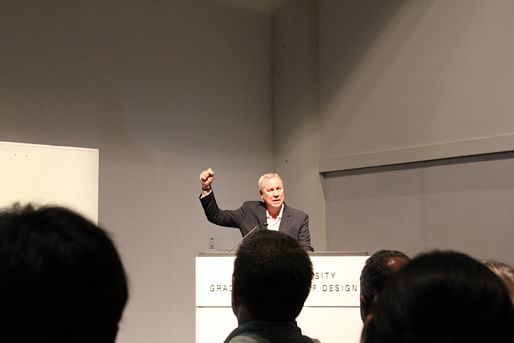
I grabbed the policeman's arm and said--why do you hit this boy? He said, it's none of your business. And I said, yes it is, I am an honest citizen. I left with the policeman and the boy to the station and on the way noticed that the sounds the boy was making were those of a deaf boy. And I went to the place where he lived with thirteen others and learned more about his situation. His [caretakers] thought he was a dullard. They said they had tested him; I asked to see the test and as far as I could tell, he knew no words. He also had no guardian.
He thought, perhaps, in terms of visual signs and symbols. I said, I don't think this test applies to this boy. The same psychologist gave him another test [something about a diagonal line in the corner of each of 200 pages] and again determined he was uneducable.
I was 27 and got a lawyer and went to court to adopt the boy. The judge asked why I thought he has intelligence--I said, because he has a sense of humor. At the end of the proceedings, I said, if you don't give me the boy, it'll cost the state of New Jersey a hell of a lot of money to lock him up, and the judge said, you've got a point. And they gave me the boy.
6:04pm: Example of films made of mothers and their babies, slowed down frame by frame. Every couple of frames, totally different expressions for mother and child. The mother lunging at the child for two frames as if attacking the baby, the child recoiling, then responding in a happier way, the mother's expression and the baby's expression changing every few frames.
6:06 pm: ...I never thought to have a career in the theater.
6:07 pm: Some things Raymond taught me. I was in an old pencil factory (?) and Raymond was on the other side, and I screamed "Raymond." and he didn't hear me. I knew if I stomped my feet he'd turn around. I screamed "Raymond" (in very low, hoarse tones), and he turned, like "hey man, you're speaking my language." His body was more attuned to those frequencies than the frequencies that hearing people are used to.
6:09 pm: Raymond was doing a performance, where he walked forwards and back and moved his arms (RW mimes it several times, silently). I encouraged him to add sound, and this is what he did. (RW mimes the same thing again several times, silently, then spreads his arms and screams, like a deranged eagle, with a high pitched sound).

It wasn't the sound that a deaf person makes, trapped inside the body.
6:11 pm: I start every rehearsal with silence.
6:14 pm: I can say, I WANT TO KILL YOU (screaming, rushing towards the school photographer in the second row). ...Or I can say, I want to kill you. (Softly, smiling). The smiling version may be more scary.
6:16 pm: The best way to hear something is to close your eyes. If you turn the TV sound off you start noticing more visual things (facial tics). I'm interested in what I can put on the stage that would help people to see (notice) better, in this say.
6:18 pm: In my work with deaf performers, I start with movement, and let the sound come from that movement. Meeting Raymond, a deaf boy who knew no words, was [very influential for me].
6:20 pm: RW performs cassette tape given to him by a professor:
Beep Beep Beep Beep Beep Beep Beep Beep Beep Beep Beep Beep Mwablahesersere Beep Beep Beep Beep Beep Sltheresalsdfjere Beep Beep Beep Emily likes the TV Because, A: she likes Mickey Mouse.
Because B: she likes Minnie Mouse.
Because A: because she watches it.
He asked the professor what the tape was, and it was a tape created by a boy living in a home for brain damaged children. RW was working on a 12 hour silent opera about Stalin at the time. My plays are very precise and I had been rehearsing 18 months. Invited the boy.
6:23 pm: I'm a prima donna when I perform and don't want to be disturbed. Half an hour before the performance was a knock "Hello this is [mother] and I brought Christopher to say hi." Opens the door and the boy stands there silently. Decides to invite the boy to be in the play. The mother asks "but what will he do?" "I don't know."
They go on stage and RW starts performing the boy's tape. Beep Beep Beep Beep Beep Beep Beep Beep Beep Beep Beep Beep Mwablahesersere Beep Beep Beep Beep Beep Sltheresalsdfjere Beep Beep Beep Emily likes the TV Because, A:
And Christopher said, she likes Mickey Mouse.
Because B:
And Christopher said, she likes Minnie Mouse.
Because A:
Because she watches it.
Christopher also performed in the next act, with a rhythmic repetition that had order in it, even though it sounded random.

Later his father called and said, Christopher never initiates conversation, but he was so thrilled about being in the play and can he be in it again? He was in the next four. Eventually Christopher came to stay with RW.
Christopher could see patterns--in no time he put together a puzzle of a Jackson Pollock painting.
6:35 pm: I studied architecture at Pratt and my best teacher was Sibyl Moholy-Nagy, who would stand at a podium, in a room too dark to take notes, and the projected images would go by fast, with no relation to her stories, which were things that historians don't tell: Frank Lloyd Wright had a flat tire and didn't know how to change it.
She said, "students, you have three minutes to design a city. Ready, go. Get out your papers." I drew an apple, and in the middle I put a crystal cube.
What impressed me about Christopher is how he coded his thoughts in math so he could readily see the whole picture.
6:40 pm: slides. 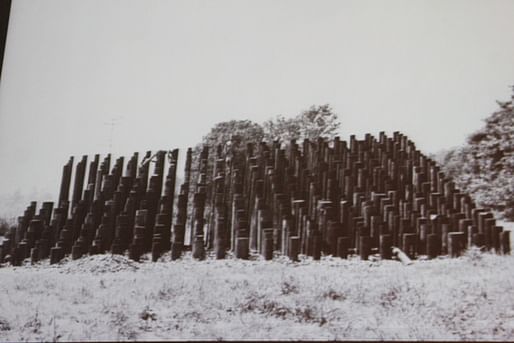
1969, with Gordon Matta Clark. Later he did his cuts through buildings.
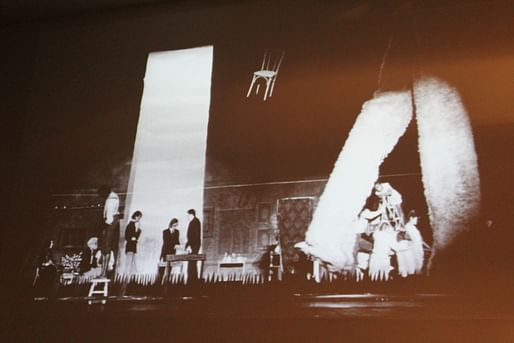
These were all non-professionals; this was an old Russian woman who made a kind of dance.
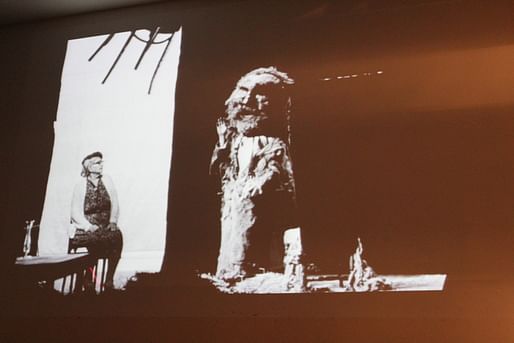 The Life and Times of Sigmund Freud. A turtle that took 35 minutes to cross the stage, these people took seconds, this other person sat immobile. LIke in this room, people have different energies and mental states.
The Life and Times of Sigmund Freud. A turtle that took 35 minutes to cross the stage, these people took seconds, this other person sat immobile. LIke in this room, people have different energies and mental states.
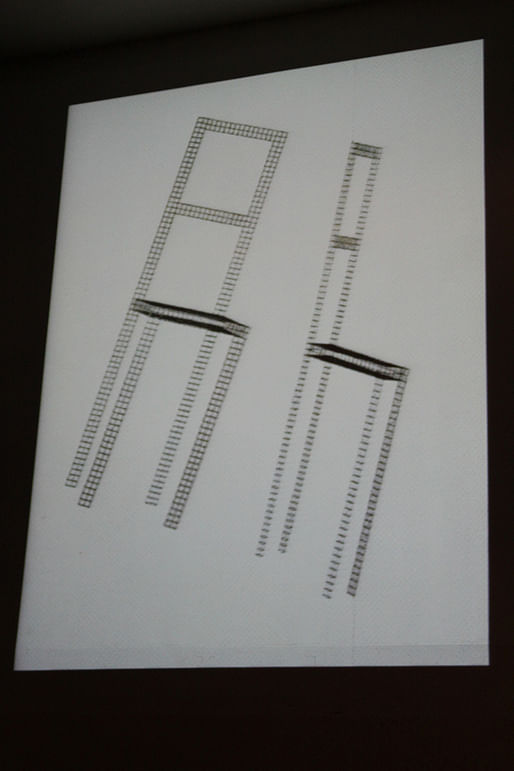 Since they beginning of my plays, I've often made furniture as part of it. This (left) is the chair itself and this (right) is the shadow of the chair.
Since they beginning of my plays, I've often made furniture as part of it. This (left) is the chair itself and this (right) is the shadow of the chair.
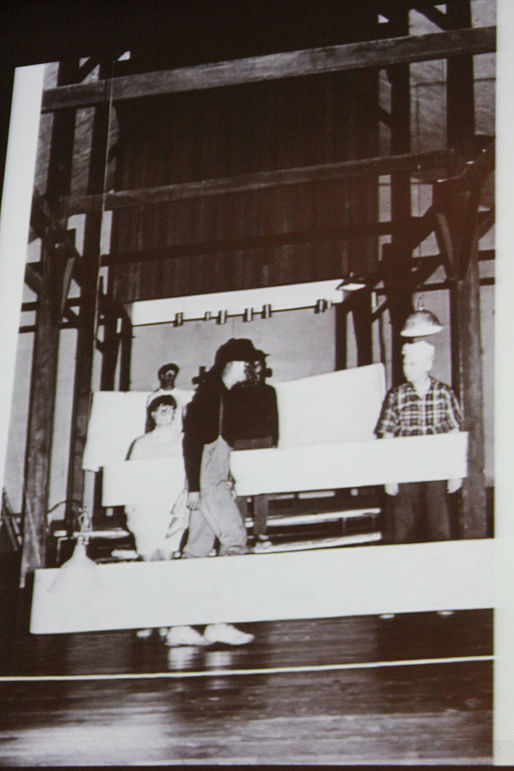
...Now many people said this work had nothing to do with Freud, and in some ways they were right. But I was thinking all the time about Freud and in another way it had everything to do with Freud. [RW explains this. The passage of time, and events in Freud's life; three phases of his life and three acts in the play.]
6:49 pm: Describes another play, 50 [55?] minutes long, in which a figure in a black Victorian gown starts facing away from the audience, then pours a glass of milk, takes it to a child sitting, gives hit to the child, the child drinks, the figure takes back the empty glass to the table, puts it down, picks up a knife, wipes it, takes it to the child, stabs the child in the chest, withdraws the knife, puts it back on the table, pours another glass of milk, takes it back to the child, the child drinks, etc. 
Who is that figure? But I love my child! We're all capable of (killing a child)--it's like the slow motion film of mothers and their babies, but with a second lasting [50 minutes].
6:58 pm: How do you write a play that's 7 hours long? How do you design a city? How do you make a building?
A play that is 7 days long. Dino dino dino dino saur saur soar soaring...and then we blew up the mountain. 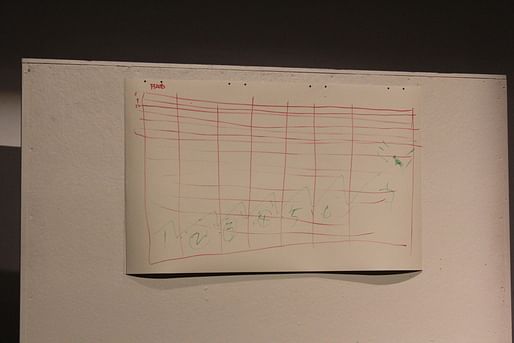
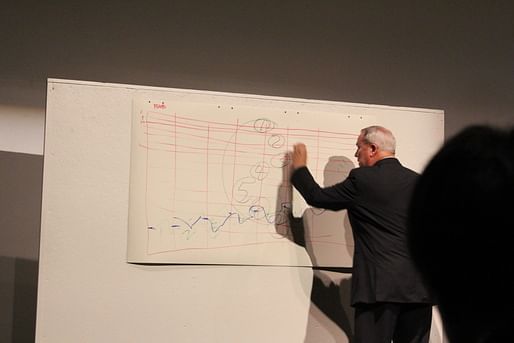
We divided it into 7 days, 24 hours. Let's take the first day, and this group of people, you're from 8 to 9 am and you do something about a flood. This group of people, you're 9 to 10 and you also do the flood. And the next day a different theme; you continue your play on the new theme.
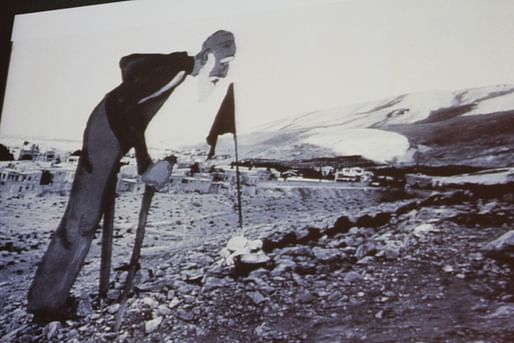
It's like building a city. The architect makes the megastructure. This person lives here in this apartment, that person lives in that apartment. The structure isn't what's important, it's how you fill it in. But I can't do it without at structure, so I start with that.
The performers were non-professionals. 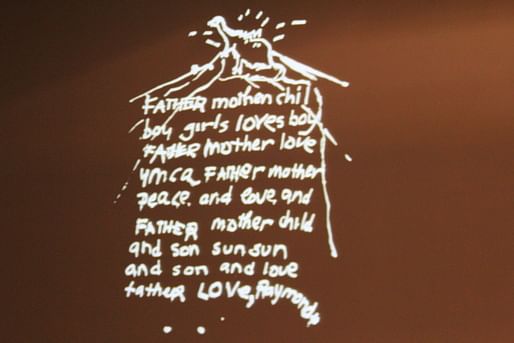
"A Letter for Queen Victoria" with Christopher Knowles. Christopher made the letters on the backdrop--there's a pattern that he saw.
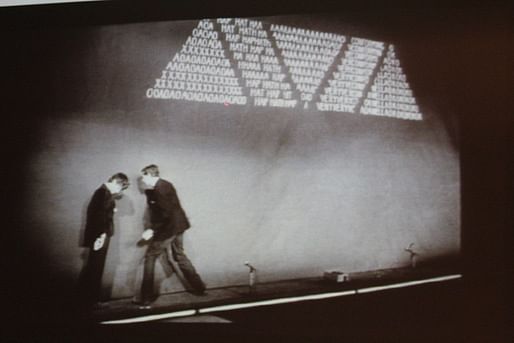
On the last day of the play, the queen of Iran was coming, and RW said to Christopher, why don't you do something special? He said, Okay, how long? However long you like. Ten minutes. Okay. So at the end of the play Christopher stands up and says "tape recorder tape recorder tape recorder tape recorder tape recorder" for ten minutes. After three minutes I started to cry, it was so beautiful, the modulation of his voice. The audience was crying too, but in the other way--when are we going to get out of here? At the end of the play, it was quiet, awkward, people just left.
Christopher said, without anger, just matter of fact:
Who cares to have your mind be so smooth.
He understood what had happened.
7:14 pm: RW's 90 year old grandmother performed in a play of his in Paris. She shows up at the airport and says, "I have to take 9 pills a day to stay alive. I take this pill, and that small pill, and that pill (etc. etc.)...Do I have to say anything in your play?" RW had her say that bit about the pills in the play.
Another play. Einstein on the Beach. Painters measure space: portraits, to still lives, to landscapes. And the play was organized in the same way.

Time is a vertical line and space is a horizontal line; that's the architecture of everything. 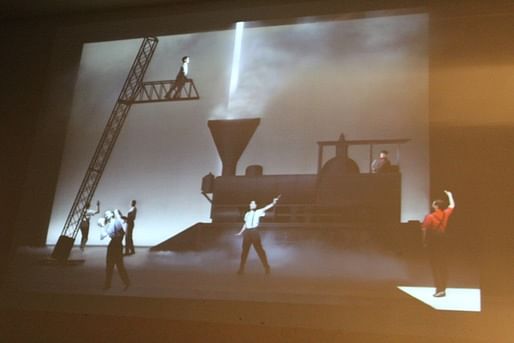

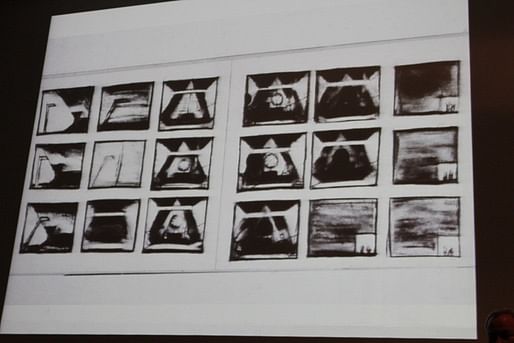 How do you stand on a stage? If you move around it's easier to hold an audience, but can you do it just standing?
How do you stand on a stage? If you move around it's easier to hold an audience, but can you do it just standing?
Jessye Norman was set to sing in a RW opera a few days after 9/11. She said she couldn't sing as she had been crying too much. RW said, we need to hear your voice now more than ever. She said she'd try. She sang, then began to cry. Then stood silently, a Nubian queen, and the audience was weeping. How many opera singers can do that?
7:28 pm: There's always movement, the body is never still.
RW criticizes TV, how every moment they're making sure you understand each thing. In Einstein on the Beach, there's nothing to understand. It's something you experience.
...
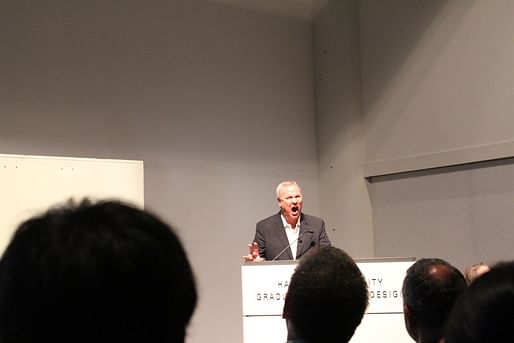
7:35 pm: Burn the schools of theater decoration! We do not need them! This is architectural.
...
7:39 pm: A bar of light on the stage for 16 minutes, with no actors or dialogue. My sister said, I don't know how you get way with it! I said, I don't know either.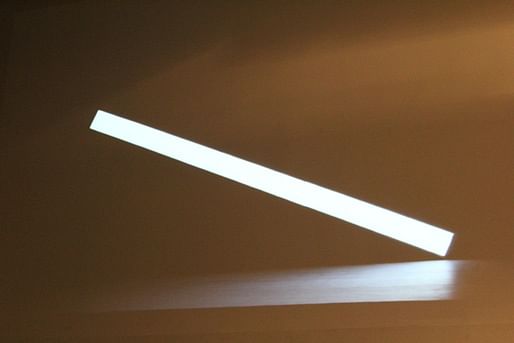
Arthur Miller sat next to me once at a performance and he didn't know who I was but I knew who he was. After 10 minutes he said, what do you think of this? I said, I don't know, what do you think? He said, I don't get it. I said, I don't either. Miller left a while after that.
In an interview Jessye Norman was asked what her favorite recording is. Without hesitation she said, "Martin Luther King's 'I have a Dream.'"
Thank you.
End.
Questions. In response to one question, RW says, to me the great opera houses of the 20th century are not la Scala, it's Madison Square Gardens, and Bruce Springsteen.
Another question about how to get over fear when trying to create something--writer's block. RW says, he feels like a six year old every time he starts a project; he's always afraid, but you do something, then react to it, and do something else.
Thanks for reading!
Lian
P.S. Saw this at the GSD:
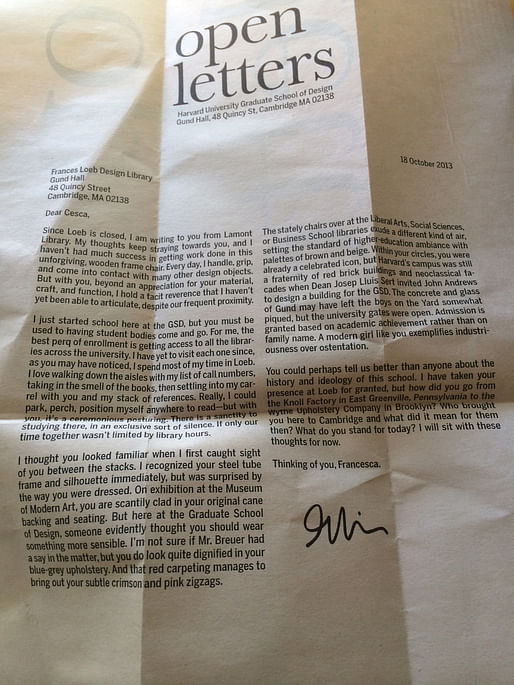
This blog was most active from 2009-2013. Writing about my experiences and life at Harvard GSD started out as a way for me to process my experiences as an M.Arch.I student, and evolved into a record of the intellectual and cultural life of the Cambridge architecture (and to a lesser extent, design/technology) community, through live-blogs. These days, I work as a data storyteller (and blogger at Littldata.com) in San Francisco, and still post here once in a while.



4 Comments
what a wild life/lecture... thanks i had never heard of RW before.
I'll admit that I'm with you on that, Nam. But he was great!
RW visited our campus when I was in architecture school. I got to hear his lecture twice--one for the school and the other for the public at large. It was pretty much the same lecture. What's fascinating about this summary is how the content of his lecture hasn't changed in 12 years, right down to his sketching out the concept for "Einstein on the Beach". As I was reading I was quietly checking off each little story he shared. Maybe I wasn't up to it at the time, but he struck me as awfully strange.
I really found it useless to attend. I really didn't learn anything, he was super weird, and it didn't relate to architecture at all.
Block this user
Are you sure you want to block this user and hide all related comments throughout the site?
Archinect
This is your first comment on Archinect. Your comment will be visible once approved.